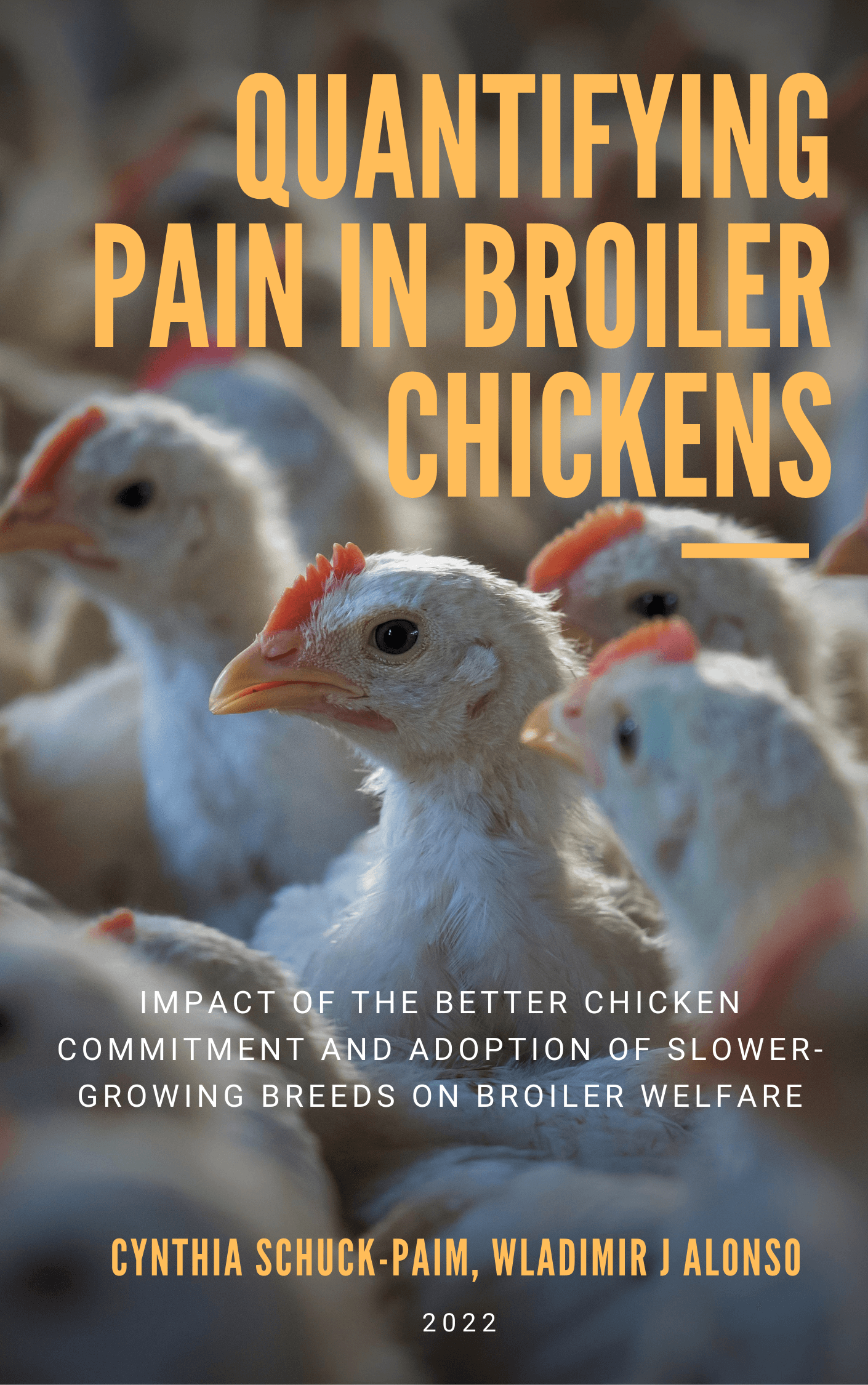Commercial broiler production represents some of the most serious animal welfare issues in the livestock industry. Over the last years, campaigns to improve the way broiler chickens are produced, including the use of slower-growing broiler strains, have been gathering pace in many countries. Currently, one of the leading standards for broiler welfare driving the food industry towards higher welfare practices is the Better Chicken Commitment (BCC), a set of recommendations that address housing, stocking density, growth rate and stunning methods.
In this project, we used the Cumulative Pain Framework to investigate how the adoption of the BCC and similar welfare certification programs affect the welfare of broilers. Specifically, we examine concerns that the use of slower-growing breeds may increase suffering by extending the life of chickens for the production of the same amount of meat.
The framework translates evidence on the duration and intensity of the pain associated with these challenges into time spent in four categories of pain intensity: Annoying, Hurtful, Disabling, and Excruciating. Pain is operationally defined as ‘any negative affective state’, thus encompassing negative affective experiences of both somatic origin (physical pain) and more related to the primary emotional systems (psychological pain). By considering the prevalence of each welfare challenge in the population, estimated times in pain are also determined for the average population member (in this case, the average commercial broiler). The method is transparent, brings important knowledge gaps into light, and incorporates uncertainty about all parameters into the final estimates.
We analyzed the following scenarios, for which data on broiler welfare was available. First, a conventional scenario represented by the use of fast-growing breeds (e.g., Aviagen Ross 308, 708, Cobb 500). Although the performance objectives of these breeds can reach as much as 70 g/day, with birds weighing 2.5 Kg in 35 days, average slaughter weight of broilers in the EU and the US is, respectively, 2.5 Kg and 2.9 Kg, reached at 42 and 47 days. This corresponds to an average daily gain (ADG) of 60 and 62 g/day, respectively. We used these values as a benchmark for typical growth rates in fast-growing strains, assuming an ADG of 61 g/day, corresponding to a slaughter weight of 2.5 Kg at 42 days. For the reformed scenario, represented by the use of a slower-growing strain, we assumed an average ADG of 45-46 g/day, hence that the same slaughter weight would be reached in approximately 56 days. This is a growth rate consistent with typical figures achieved by various of the breeds approved under the BCC (e.g. JA 987, 787, Ranger Gold), also referred to as medium- or intermediate-growing broilers. This growth rate also falls within the acceptability of other welfare certification schemes, such as the ‘Beter Leven’ program in the Netherlands and the ‘Deutsche Tierschutzbund’ in Germany, which determine a growth rate of up to 45 g/day, and a minimum lifespan of 56 days. Importantly, data on the incidence of important welfare challenges in slower-growing breeds (e.g. proportion of birds with different degrees of lameness) is available predominantly for birds growing at approximately this rate.
In both scenarios, we focused on key welfare challenges affecting broilers: gait-impairing conditions (lameness), cardiovascular problems, thermal stress, the frustration potentially arising from the deprivation of various motivated behaviors, chronic hunger in broiler breeders and the welfare harms endured during stunning and slaughter. This is, however, not an exhaustive list of every welfare harm affecting broilers, hence Cumulative Times in Pain underestimate the typical times in pain endured by broilers in commercial production. Because the welfare harms not considered (e.g. infectious diseases, inflammatory conditions, contact dermatitis, muscle abnormalities, additional negative effects of feed deprivation in conventional breeders other than chronic hunger) have a higher incidence in fast-growing birds, the estimates presented are conservative, representing the minimum time in pain expected to be averted with implementation of the BCC and similar standards.
A summary of key findings is available below. They have been also featured by Our World in Data.

All methods, assumptions, justifications and results are discussed thoroughly in the book “Quantifying pain in broiler chickens”, available below and on Amazon.

All parameter values used for the analysis (estimates of duration, intensity, number of occurrences, and the prevalence of each welfare offense) are justified in the book “Quantifying Pain in Broilers” (see above). However, we invite the reader to examine the extent to which the estimates presented here are sensitive to our choices and assumptions, at the platform https://pain-track.org/broilers. In this web application, all parameter values can be altered, with the automatic update of all estimates.

